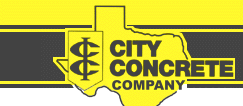 |
 |
 |
|
|
|
|
|
Weather Conditions |
Contractor TipsProfessional Contractor -Curing Concrete
- To have a better chance of getting concrete when you want it, order concrete 24 hours in advance. If you are placing a large order (100 yards or greater), let dispatch know days in advance that you may pour.
- Confirm "will call" orders 2 hours in advance.
- Order as close to the quantity that you need as possible (i.e.; if you need 110+, don't order 70+ and call for a 45 yard balance. A one load balance is planned with "+ orders". A 2 or more load balance hurts the dispatcher's ability to service your order.
- Have good directions, a street address, and a zip code when placing an order. "You've been there before" is not considered good directions.
- If you need to change an order, call dispatch at least one hour before the concrete is expected on the job site.
- Let dispatch know of any slowdowns on the job that will affect the mixer truck returning to the plant.
- Don't use water to make a high slump mixture. If you need to place "loose" concrete, ask our quality control department or a salesman to help with a mix that will work for you.
- Get to know slump. Ask our quality control department for help.
- If the job might be difficult to get into, ask for a salesman to come out and look the job over.
- Have only one person on the job site giving directions/instructions to the drivers. Be willing to help back trucks into or out of the job.
- When guiding a truck, watch overhead for low wires and branches.
- Use at least a 4000psi concrete mix when placing exterior flatwork.
- Cure your concrete.
- Do not perform any finishing operations until all surface water has disappeared (until the surface of the fresh concrete has dulled).
- Do not hard trowel exterior flatwork.
- Be careful when working around the truck and the chutes. Never work or walk underneath chutes.
- We cannot carry extra chutes on the truck.
- Remember, even if we have a truck in the yard and under the plant, loading when you call it is still going to take approximately 30 minutes until the truck arrives on your job.
- Order 10% extra concrete to account for spreading forms, uneven sub-grade, settlement of the sub-grade, etc.
- Never spray water on the surface of fresh concrete until it has hardened.
- Cut joints in flatwork 2V2 feet apart for each inch of thickness (i.e.; if the slab is 4 inches thick, a joint should be cut every 10 feet).
Proper Placement and Consolidation of concrete won't allow you to enjoy the full benefits of the concrete unless it is properly CURED.
Curing defined is the maintenance of a satisfactory moisture content and temperature in concrete during some definite period immediately following placing and finishing so that the desired properties of the concrete may develop.
Some ways of curing are, but not limited to
- Curing liquid membranes applied at the manufacture's prescribed rate.
- Fogging with a fog nozzle with a limitation of a V2 gallon per minute spray.
- Wet Burlap
- Plastic Sheets -Caution must be used. contact with the concrete surface may discolor it.
- Curing Paper
- Wet Sand
- Spraying it -Caution must be taken when used. The concrete surface must be hard enough that the water does not delaminate the surface.
- Combination of any
- Cold Weather ACI 306 explains cold weather curing
- Hot Weather ACI 305 explains hot weather curing
After November 1st or when the weather cannot maintain an average temperature of 50º F for three days or longer, wet burlap, fogging, spraying, plastic sheets, curing paper, tarpaulins, wet sand, or a combination can be used. Discretion should be used during this period of time as to ensure that the concrete moisture has evaporated before freezing weather can occur.
Curing compounds should be approved by ASTM C-1315
 Abilene
Abilene Amarillo
Amarillo Austin
Austin Bonham
Bonham College Station
College Station Dallas/Fort Worth
Dallas/Fort Worth Houston
Houston Lubbock
Lubbock Oklahoma City
Oklahoma City San Angelo
San Angelo Sherman
Sherman Tyler
Tyler Wichita Falls
Wichita Falls


